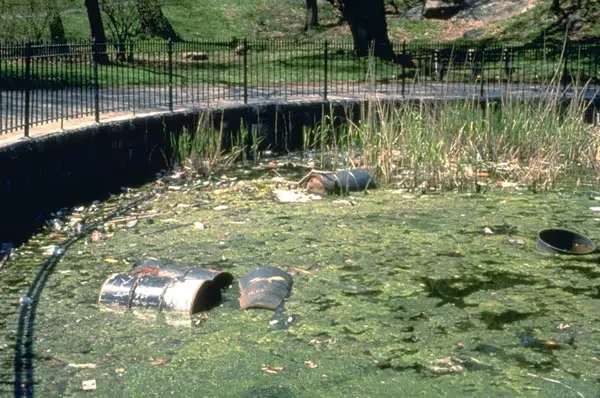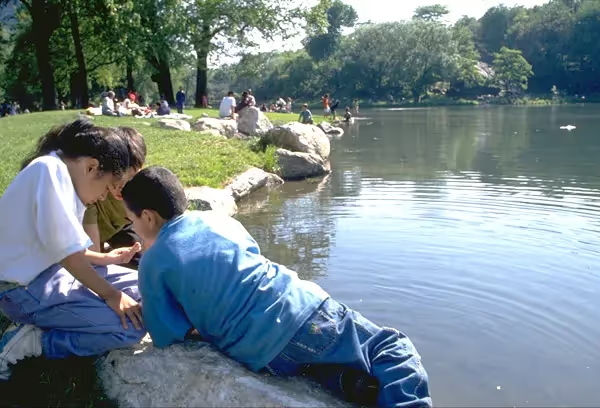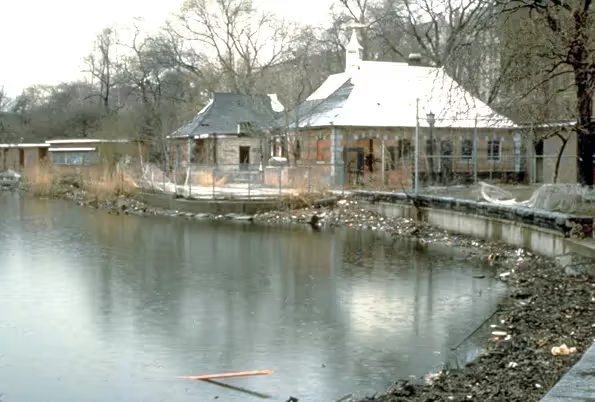A biweekly newsletter with public space news, resources, and opportunities.
A curated dispatch on all things public markets plus the latest announcements from the Market Cities Program.
Please note that these Hall of Shame nominations were written in a moment in time (most over a decade ago) and likely have since changed or even been transformed. If the above entry is now great, or still not so great, go ahead and comment below on how it has evolved or nominate it as a great place.

An 11-acre lake surrounded by a rugged landscape of woodlands and dramatic rock outcroppings.

The Meer (Dutch for "lake") is the idyllic setting of the Charles A. Dana Discovery Center, one of the Park's four visitor centers and home to a wide variety of the Central Park Conservancy's free family and community programs. The serene naturalistic landscape of the Meer and stunning views of its picturesque surroundings entice visitors in from nearby Fifth Avenue and 110th Street and encourage them to linger, observe, and explore. Add to this the Dana Discovery Center, built in 1993, and you have the perfect complement to the 65-acre landscape: a focal point for information, amenities, and programs.
Immediately accessible from Fifth Avenue and 110th Street, the path around the Meer is a pleasant alternative for people en route between Harlem and the Upper East Side. The Dana Center, just inside the Park on 110th Street and Lenox Avenue, is just a few hundred feet from the 110th Street subway station on the 2/3 line. While it is highly accessible to the immediately surrounding community, the Meer remains one of the better kept secrets from most users of the rest of the Park. This is due to the extreme natural topography of the northern portion of the parkë‹the rugged landscape of the North Woods lies between the Meer and meadows to the southë‹but those trail enthusiasts who make their way north through this rocky woodland will discover the Meer on the other side. Wandering to the southeastern end of the Meer, visitors may stumble upon another best kept secret: the beautiful Conservatory Garden, located inside the Park at Fifth Avenue and 105th Street.
Many visitors consider the restored Harlem Meer one of the Park's most beautiful landscapes, and great care has been taken in its restoration to encourage visitors to spend time there. Seating along the pathway that sweeps around the outside of the shoreline invites passers-through to sit and stay a while, and enables parents to enjoy the view while monitoring children in one of the perimeter playgrounds. The landscape itself is designed to be inviting and accommodating. A cove in the southeast corner of the water has steps going down to the water's edge. There visitors can sit surrounded by native plants _ roses, hydrangeas, pickerel weed, and irises _ that spill down the slope and to the water's edge. The small beach is another feature that encourages visitors to experience the shoreline.
By far the most popular activity of the Meer is unstructured enjoyment of the landscape: exploring nature, observing wildlife, picnicking and just relaxing along the shoreline. Two perimeter playgrounds are frequented by families with young children. The Dana Discovery Center is home to a wide variety of the Central Park Conservancy's free family and community programs, including park-related tours and exhibits, catch-and-release fishing, summer jazz concerts, and other seasonal events (such as the Halloween Pumpkin Sail of candlelit Jack O'Lanterns across the Meer).
The Meer is proof that places which inspire delight and curiosity bring people together. The beauty and serenity of the landscape have an undeniable transformative effect, creating a sense of shared appreciation and breaking down any barriers even between strangers, who frequently are moved to share their observations and inquiries with one another.
Central Park north of 96th Street is more rugged and picturesque than its southern counterpart. The pre-Park northern terrain was naturally wilder, with large rocky outcroppings amid low-lying areas. When designer Frederick Law Olmsted and Calvert Vaux first surveyed the proposed park land, they decided that a rugged terrain would be the ideal complement to their southern pastoral vision. They also decided that it would be far too costly to reshape the natural northern geography. In fact, pragmatism dictated the extension of the Park from its original northern border of 106th Street to 110th Street; development of the rocky and swampy area would have been impractical, so the swamp was transformed into Harlem Meer and the surrounding woodland came to include a planted Ravine and rustic waterfall. A 1940s reconstruction changed the Meer's existing soft grassy shoreline to a concrete and fenced edge, but in 1993 the Central Park Conservancy completed a restoration that returned the shoreline to Olmsted's original vision, with a miniature sandy beach added for whimsical effect. A small island was created in the southwestern corner of the Meer, replacing an original island that was lost when part of the lake was filled for the construction of Lasker Rink and Pool in 1966. The naturalization of the shoreline, reintroduction of a wide variety of native plants, and the creation of "Duck Island," provide an endless supply of visual interest and have transformed the 65-acre landscape into a haven for people and wildlife.






*Please note that these Hall of Shame nominations were written in a moment in time (most over a decade ago) and likely have since changed or even been transformed. If the above entry is now great, or still not so great, go ahead and comment below on how it has evolved or nominate it as a great place.